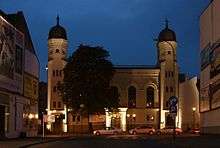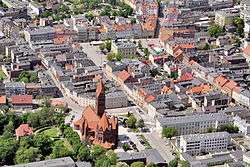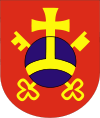Ostrów Wielkopolski
| Ostrów Wielkopolski | |||
|---|---|---|---|
|
Skyline | |||
| |||
 Ostrów Wielkopolski | |||
| Coordinates: 51°39′N 17°42′E / 51.650°N 17.700°E | |||
| Country |
| ||
| Voivodeship | Greater Poland | ||
| County | Ostrów Wielkopolski County | ||
| Gmina | Ostrów Wielkopolski (urban gmina) | ||
| Established | 14th century | ||
| Town rights | 15th century | ||
| Government | |||
| • Mayor | Beata Klimek | ||
| Area | |||
| • Total | 41.9 km2 (16.2 sq mi) | ||
| Highest elevation | 175 m (574 ft) | ||
| Lowest elevation | 123 m (404 ft) | ||
| Population (2008) | |||
| • Total | 72,360 | ||
| • Density | 1,700/km2 (4,500/sq mi) | ||
| Time zone | CET (UTC+1) | ||
| • Summer (DST) | CEST (UTC+2) | ||
| Postal code | 63-400 to 63-417 | ||
| Area code(s) | +48 62 | ||
| Car plates | POS | ||
| Climate | Cfb | ||
| Website | http://www.umostrow.pl/ | ||
Ostrów Wielkopolski ([ˈɔstruf vʲɛlkɔˈpɔlskʲi]) (often abbreviated Ostrów Wlkp., formerly called only Ostrów, German: Ostrowo, Latin: Ostrovia) is a city in central Poland with 72,360 inhabitants (2008), situated in the Greater Poland Voivodeship; the seat of Ostrów Wielkopolski County.
History
Recently, a small fortified dwelling dating from the 10th century was discovered on the north-east side of the town's limits. An archeological excavation is now in progress.
Ostrów received town privileges in 1404 but the economic stagnation caused by fires, wars, and a weak 16th-century nobility, led to the town’s officials dropping its town status in 1711. In 1714, one of the nobility of Ostrów, Jan Jerzy Przebendowski, intervened at the royal court, for the status to be reinstated. By the power of a Royal Marshall (English: Marshal), Franciszek Bielinski, the town received its status back with greater privileges. Another noble family, the Radziwiłłowie took patronage over the town and looked over its many investments. The care of the town’s owners, work of its people, and dedication of its officials, as well as its location, favored the town’s continuous growth. The establishment of a railroad hub in Ostrów was a vital turning point in its development, helping to lend the town prominent status on the local and national scene.
During the time of Partition and both World Wars, Ostrów became an important center for nationalist movements. One of the town’s historic episodes was the so-called Republic of Ostrów (Republika Ostrowska), which was the citizens’ upheaval of 1918. No blood was shed at that upheaval and all political powers were taken over from the Prussian authorities. In between the First and Second World Wars, Ostrów was one of the fastest growing towns: the number of inhabitants doubled, showy houses were built and modern railcar manufacturing (Fabryka Wagon) began.
During World War II, a Nazi labor camp, Staatspolizeistelle Litzmannstadt Arbeitserziehungslager Ostrowo,[1] operated within the town's limits, where 193 people died. The town was one of the major anti-Nazi conspiracy centers in the Great Poland region. In 1941, after the Gestapo’s crackdown on the headquarters of the Poznań branch of the underground army Union for Armed Struggle-ZWZ, the headquarters were moved to Ostrów. From here the re-structure of the Poznań region of the Union was conducted.
Notable residents
- Moritz Landé (1829–1888) – German architect
- Ehrenfried-Oskar Boege (1889–1965) – German general
- Paweł Bryliński – folklore sculptor
- Heinrich Graetz – historian
- Mirosław Ferić - fighter pilot for 303 Squadron during Second World War
- Jarosław Iwaszkiewicz – poet, writer (Letters from Ostrów)
- Bartłomiej Jaszka – star handball player
- Krzysztof Komeda – jazz pianist
- Krzysztof Lijewski –star handball player
- Marcin Lijewski – star handball player
- Władysław Marcinkowski – sculptor
- Władysław Markiewicz – sociologist
- Bernhard Rawitz – German anatomist
- Manfred von Richthofen – "Red Baron", German fighter pilot (World War I) - briefly stationed in the city's cavalry unit before being sent to the Western Front.
- Jan Żniniewicz – physician, author of the new method of hydrotherapy (balneological method of treatment of chronic rheumatic diseases)
- Krzysztof Kwiatkowski – computer scientists & researcher, software developer
- Witold Kaczmarzyk – seminarian at SS. Cyril & Methodius Seminary in Orchard Lake, MI for the Archdiocese of Denver, CO (USA)& marathoner, conqueror of the Crown of the Polish Marathons as a seminarian, former tutor of physics and mathematics
Education
- Społeczna Wyższa Szkoła Przedsiębiorczości i Zarządzania in Łódź, branch in Ostrów Wlkp.
- Technical University of Łódź, branch in Ostrów Wlkp.
Sports
- Stal Ostrów Wielkopolski - men basketball team, 7th in Dominet Bank Ekstraliga in 2006/2007 season.
- Ostrovia 1909 Ostrów Wielkopolski - men soccer team
- KM Ostrów Wielkopolski - speedway team
From 5 July to 20 July 2013 Ostrów Wielkopolski hosted the 17th European Gliding Championships. The local pilot, Łukasz Błaszczyk, took bronze medal in the Club Class.[2]
- Old school
 Ostrow city-hall
Ostrow city-hall Former synagogue
Former synagogue Main station
Main station
International relations
Twin towns — Sister cities
Ostrów Wielkopolski is twinned with:
|
References
- Notes
External links
| Wikimedia Commons has media related to Ostrów Wielkopolski. |
Coordinates: 51°39′N 17°42′E / 51.650°N 17.700°E



